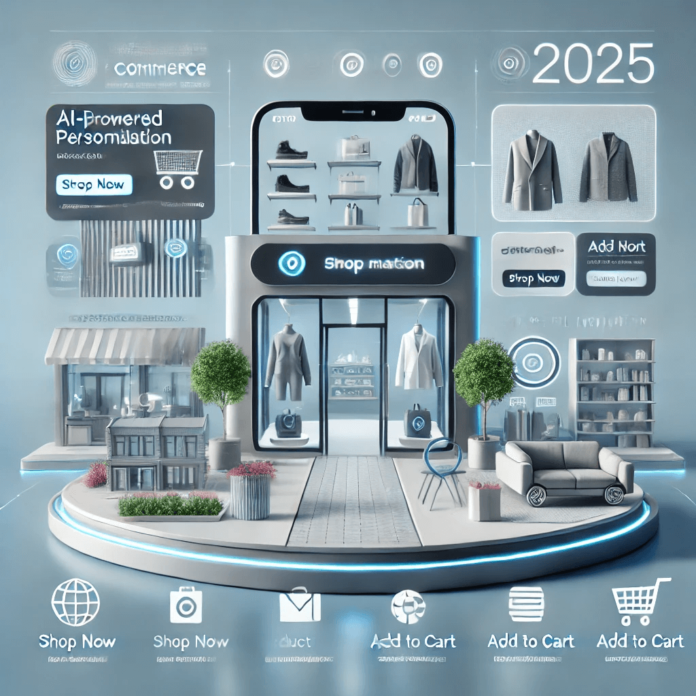Introduction
- Key Elements of E-commerce Website Design in 2025
- Personalization and AI Integration
- User-Friendly Navigation and Accessibility
- Boosting Trust and Security
- Leveraging Content and Marketing
- Social Integration and Conversion Features
- Future Trends in E-commerce Website Design
- Case Studies: E-commerce Success with Modern Design
- E-commerce Web Design 2025: Trends Shaping Online Retail
- Conclusion
Crafting the perfect e-commerce web design in 2025 requires balancing aesthetics, functionality, and user-centric features. With the online retail space becoming increasingly competitive, following the best e-commerce practices ensures your store stands out and delivers exceptional user experiences. From leveraging responsive layouts to integrating personalized recommendations, online store design tips focus on driving engagement and boosting conversions. This guide explores actionable strategies to elevate your e-commerce site, providing insights into the latest trends and techniques to help your business thrive in the digital age.
Key Elements of E-commerce Website Design in 2025
1. Prioritize Mobile-First Design
The mobile-first design ensures your e-commerce site is optimized for the majority of users accessing it from smartphones.
Why It Matters:
Mobile shopping is expected to account for over 70% of e-commerce sales.
How to Implement:
- Use responsive layouts.
- Simplify navigation for touchscreens.
- Ensure fast load times.
2. Fast Loading Speeds
Page speed directly impacts user satisfaction and conversions.
Optimization Tips:
- Compress images using modern formats like WebP.
- Leverage a Content Delivery Network (CDN) to ensure fast and efficient global content distribution, improving website performance and user experience.
- Minimize JavaScript and CSS files.
3. Clean and Minimalist Layouts
Minimalist designs enhance the focus on your products.
Benefits:
- Reduced distractions for shoppers.
- Faster page loads.
- Improved visual appeal.
Best Practices:
- Use white space to highlight product images.
- Limit text clutter and focus on essential details.
Personalization and AI Integration
4. AI-Powered Personalization
Personalization is key to engaging users and increasing sales.
Examples of AI Integration:
- Product recommendations based on browsing history.
- Dynamic content tailored to user preferences.
- AI-driven chatbots for real-time support.
5. Voice Search Optimization
Voice commerce is growing rapidly. Optimize your site to capture voice-driven traffic.
How to Prepare:
- Use conversational keywords in product descriptions.
- Include voice-enabled search functionality.
6. Immersive Product Displays
Augmented Reality (AR) and 360-degree product views enhance decision-making.
Why It Works:
- Shoppers can visualize products in their environment.
- Reduces return rates by setting realistic expectations.
User-Friendly Navigation and Accessibility
7. Intuitive Navigation
Ensure seamless navigation to help customers explore your site effortlessly.
Features to Include:
- Clear menu categories.
- Breadcrumb navigation.
- Search bars with autocomplete functionality.
8. Accessibility Features
Inclusive design ensures usability for all customers, including those with disabilities.
Key Elements:
- Alt text for images.
- Keyboard navigation compatibility.
- High-contrast themes.
Boosting Trust and Security
9. Emphasize Trust Signals
Building trust is essential for converting visitors into buyers.
Trust-Building Practices:
- Display customer reviews and ratings prominently.
- Showcase secure payment badges.
- Use HTTPS for encrypted connections.
10. Transparent Checkout Processes
Simplify the checkout process to reduce cart abandonment.
Tips:
- Offer guest checkout options.
- Minimize required form fields.
- Provide multiple payment methods, including mobile wallets.
Leveraging Content and Marketing
11. Optimize for SEO
SEO drives organic traffic to your e-commerce site.
Focus Areas:
- Write unique, keyword-rich product descriptions.
- Use schema markup for rich snippets.
- Optimize meta tags for search engines.
12. Engaging Content Strategies
Content marketing can attract and retain customers.
Ideas for E-commerce Content:
- Product tutorials and demos.
- Customer success stories and testimonials.
- Seasonal buying guides.
Social Integration and Conversion Features
13. Integrate Social Proof
Showcasing user-generated content builds authenticity and trust.
Examples:
- Instagram feeds featuring customers using your products.
- Customer review videos on product pages.
14. Include Clear CTAs
Drive conversions with strategic calls to action.
Best Practices:
- Encourage engagement with bold, actionable phrases such as ‘Shop Now’ or ‘Add to Cart’ to drive user actions and boost conversions effectively.
- Position your CTAs prominently above the fold and close to key product information for maximum impact.
15. Offer Subscription Services
Recurring revenue models like subscriptions can increase customer loyalty.
How to Implement:
- Offer discounts for subscribing to products.
- Use email reminders for renewals.
Future Trends in E-commerce Website Design
16. Sustainability-Focused Design
Highlight your commitment to sustainability to appeal to eco-conscious shoppers.
Examples:
- Use green-themed visuals.
- Include details about eco-friendly practices or packaging.
17. Advanced Analytics and AI Insights
AI-driven analytics can optimize your design and marketing efforts.
Benefits:
- Identify shopping trends.
- Predict customer behavior.
Case Studies: E-commerce Success with Modern Design
Case Study 1: Fashion Brand Transformation
- Problem: Low engagement on mobile.
- Solution: Introduced a mobile-first layout and AR fitting rooms.
- Result: 50% increase in mobile conversions.
Case Study 2: Electronics Store Optimization
- Problem: High cart abandonment rates.
- Solution: Simplified checkout process and added trust signals.
- Result: 30% reduction in cart abandonment.
E-commerce Web Design 2025: Trends Shaping Online Retail

The e-commerce landscape is evolving rapidly, and 2025 brings a host of design trends that enhance user experiences and drive conversions. Implementing these practices ensures your online store meets the expectations of modern shoppers.
Key Trends in E-commerce Web Design for 2025
- Personalized Shopping Experiences
Online stores now leverage AI and machine learning to tailor experiences. Personalized product recommendations and dynamic content keep users engaged and increase sales. - Mobile-First Design
With mobile commerce dominating the industry, responsive layouts and seamless mobile navigation are no longer optional. Prioritize fast-loading, touch-friendly designs to cater to smartphone users. - Immersive Visual Content
High-quality images, 360-degree views, and video demos create an interactive shopping experience. Interactive elements like 360-degree views and AR tools enable customers to visualize products clearly, helping them make confident and informed decisions. - Voice Search Optimization
As voice search grows in popularity, optimizing product descriptions and site content for voice queries ensures better visibility and accessibility. - Sustainable Design Practices
Eco-conscious consumers value brands that align with their values. Highlight sustainability through minimalist designs and green-themed aesthetics.
By incorporating these trends into your e-commerce strategy, your site can deliver exceptional user experiences while keeping up with industry demands.
Conclusion
E-commerce website design in 2025 emphasizes user-centric layouts, fast-loading pages, and advanced personalization. By following these best practices, businesses can enhance usability, build trust, and drive higher conversions. Regular updates and adopting emerging trends will ensure your site stays competitive in the evolving digital landscape. Focus on delivering exceptional experiences to turn visitors into loyal customers and thrive in the world of online commerce.
Investing in these e-commerce web design trends not only improves user satisfaction but also boosts conversions and brand loyalty. Stay ahead of the curve by continuously adapting your online store to meet technological advancements and consumer demands.














